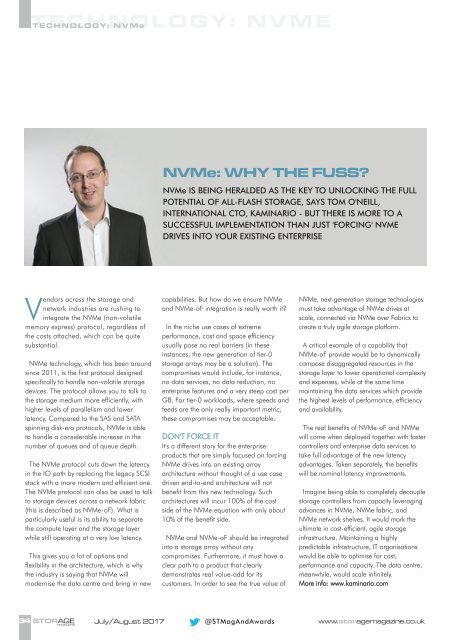ST1707
You also want an ePaper? Increase the reach of your titles
YUMPU automatically turns print PDFs into web optimized ePapers that Google loves.
TECHNOLOGY: NVMe<br />
NVME<br />
NVMe: WHY THE FUSS?<br />
NVMe IS BEING HERALDED AS THE KEY TO UNLOCKING THE FULL<br />
POTENTIAL OF ALL-FLASH STORAGE, SAYS TOM O'NEILL,<br />
INTERNATIONAL CTO, KAMINARIO - BUT THERE IS MORE TO A<br />
SUCCESSFUL IMPLEMENTATION THAN JUST 'FORCING' NVME<br />
DRIVES INTO YOUR EXISTING ENTERPRISE<br />
Vendors across the storage and<br />
network industries are rushing to<br />
integrate the NVMe (non-volatile<br />
memory express) protocol, regardless of<br />
the costs attached, which can be quite<br />
substantial.<br />
NVMe technology, which has been around<br />
since 2011, is the first protocol designed<br />
specifically to handle non-volatile storage<br />
devices. The protocol allows you to talk to<br />
the storage medium more efficiently, with<br />
higher levels of parallelism and lower<br />
latency. Compared to the SAS and SATA<br />
spinning disk-era protocols, NVMe is able<br />
to handle a considerable increase in the<br />
number of queues and of queue depth.<br />
The NVMe protocol cuts down the latency<br />
in the IO path by replacing the legacy SCSI<br />
stack with a more modern and efficient one.<br />
The NVMe protocol can also be used to talk<br />
to storage devices across a network fabric<br />
(this is described as NVMe-oF). What is<br />
particularly useful is its ability to separate<br />
the compute layer and the storage layer<br />
while still operating at a very low latency.<br />
This gives you a lot of options and<br />
flexibility in the architecture, which is why<br />
the industry is saying that NVMe will<br />
modernise the data centre and bring in new<br />
capabilities. But how do we ensure NVMe<br />
and NVMe-oF integration is really worth it?<br />
In the niche use cases of extreme<br />
performance, cost and space efficiency<br />
usually pose no real barriers (in these<br />
instances, the new generation of tier-0<br />
storage arrays may be a solution). The<br />
compromises would include, for instance,<br />
no data services, no data reduction, no<br />
enterprise features and a very steep cost per<br />
GB. For tier-0 workloads, where speeds and<br />
feeds are the only really important metric,<br />
these compromises may be acceptable.<br />
DON'T FORCE IT<br />
It's a different story for the enterprise:<br />
products that are simply focused on forcing<br />
NVMe drives into an existing array<br />
architecture without thought of a use case<br />
driven end-to-end architecture will not<br />
benefit from this new technology. Such<br />
architectures will incur 100% of the cost<br />
side of the NVMe equation with only about<br />
10% of the benefit side.<br />
NVMe and NVMe-oF should be integrated<br />
into a storage array without any<br />
compromises. Furthermore, it must have a<br />
clear path to a product that clearly<br />
demonstrates real value-add for its<br />
customers. In order to see the true value of<br />
NVMe, next-generation storage technologies<br />
must take advantage of NVMe drives at<br />
scale, connected via NVMe over Fabrics to<br />
create a truly agile storage platform.<br />
A critical example of a capability that<br />
NVMe-oF provide would be to dynamically<br />
compose disaggregated resources in the<br />
storage layer to lower operational complexity<br />
and expenses, while at the same time<br />
maintaining the data services which provide<br />
the highest levels of performance, efficiency<br />
and availability.<br />
The real benefits of NVMe-oF and NVMe<br />
will come when deployed together with faster<br />
controllers and enterprise data services to<br />
take full advantage of the new latency<br />
advantages. Taken separately, the benefits<br />
will be nominal latency improvements.<br />
Imagine being able to completely decouple<br />
storage controllers from capacity leveraging<br />
advances in NVMe, NVMe fabric, and<br />
NVMe network shelves. It would mark the<br />
ultimate in cost-efficient, agile storage<br />
infrastructure. Maintaining a highly<br />
predictable infrastructure, IT organisations<br />
would be able to optimise for cost,<br />
performance and capacity. The data centre,<br />
meanwhile, would scale infinitely.<br />
More info: www.kaminario.com<br />
^<br />
34 STORAGE July/August 2017<br />
@STMagAndAwards<br />
www.storagemagazine.co.uk<br />
MAGAZINE

















